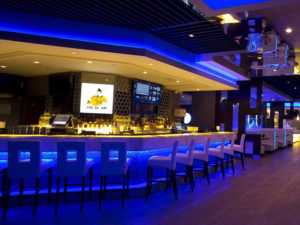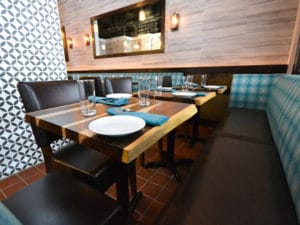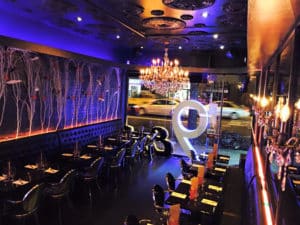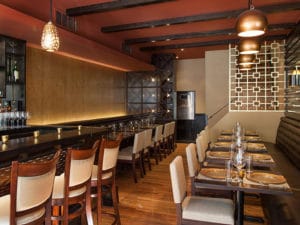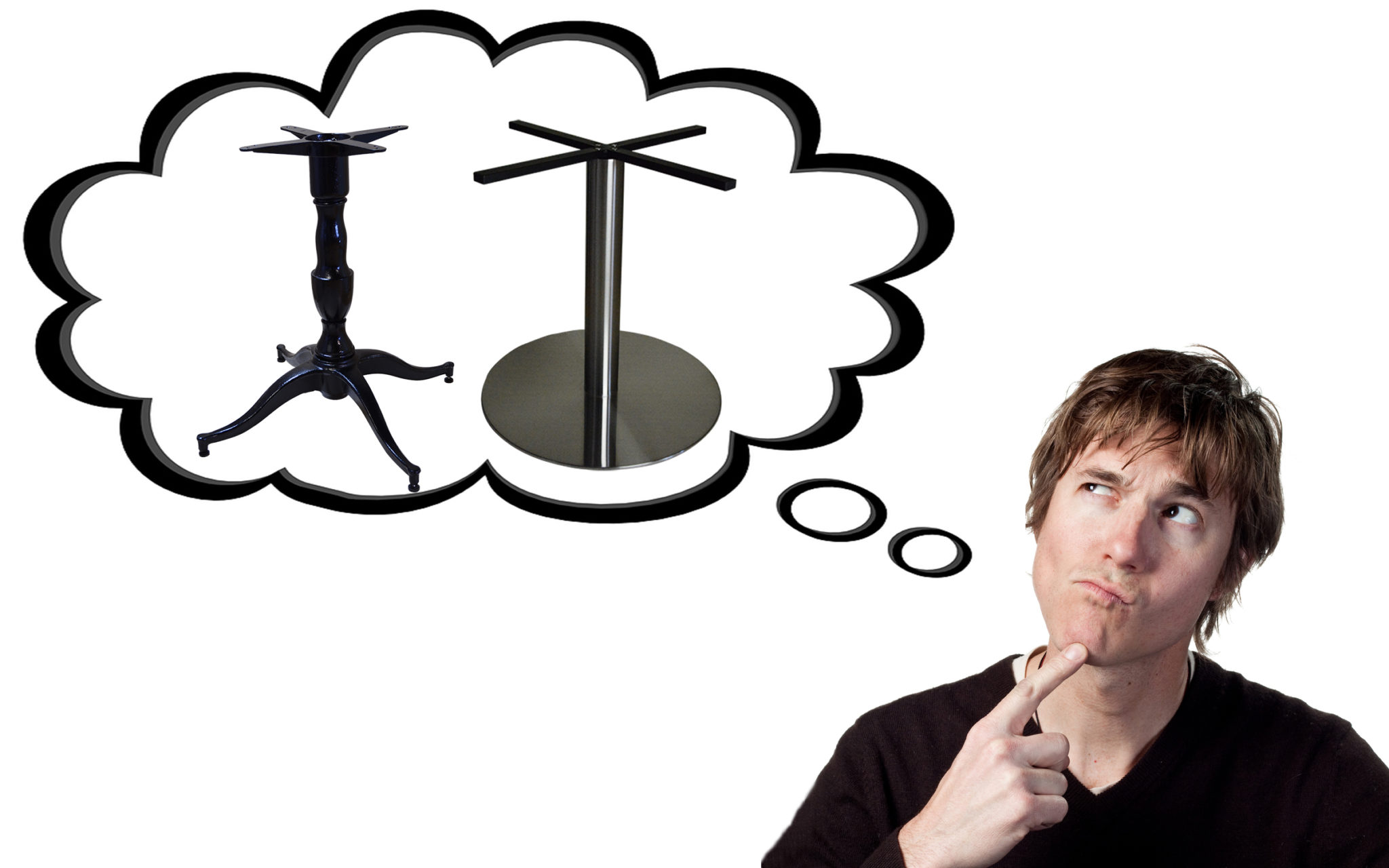Finding the perfect tables for your restaurant can be an ordeal of epic proportions. Even after you find the table top of your dreams. How do you determine which bases to use for your table? Should I buy t-style bases, or one x-style base? What material should my base be made of? What’s a base spread? What type of height should I have for my base? This guide is here to provide information on how to best select the table bases for your restaurant.
Plan it out:

The process isn’t as complicated as it seems. Start by looking at your restaurant dining space and determining which tables would be best placed where. Map it out on paper and see if your design is suitable for your space. Would a round table be better in that corner? Would a row of rectangular tables work better? (Please check out our
Seating Capacity and Layout Guide for more info) Once that is plotted out, plan for table flow, meaning the flow from customers or servers to their tables. This is all so that chairs aren’t brushing up against anything and that servers and customers can reasonably stride to their seats. After all that is planned out, you can start buying table tops, suitable to the designs of your restaurant. But as restaurateurs know, restaurant tables come in parts to allow for customization for restaurant needs.
The Right Fit:

Next step is to start shopping for the table tops but try to keep in mind your restaurant’s theme and what table bases you’d like to use. Keep in mind that not all Table Bases works with EVERY Table Top. For example, let’s say you have a circular bar height table and a rather thick table base. Chances are your patrons will have little leg room under their table. Another example, let’s suppose you buy a wide rectangular dining table but decide to go with a narrow table base at the center of the table. If someone leans heavily on that table, their food and drinks would go everywhere, leaving you some very dissatisfied patrons. Neither situation is ideal for a dining experience, so we bring up the importance of the correct table bases for your table tops.
Type of Bases:

There are various factors to consider when selecting a table base for your desired table tops. To start with the type of table base is crucial to how the table is supported. Round bases are great for Round table tops, square tables of moderate size are great for x-shaped bases and tripod bases, for tables with very long lengths of 72” inches or more (e.g. conference room, dining tables), its recommended to use t-shape bases (also known as end-bases, ADA bases or 5” x 22” bases) because they have 2 prongs each but are set at each end of the table. This provides support for the entire table and seating room for patrons and cleaner storage of chairs when not in use. Cantilever bases are bracketed to the walls. These types of bases aren’t seen as often as the others at a restaurant, but if you attend a diner, that is how the tables are mounted to the walls!
Base Height:

The height of your table bases can make all the difference in the atmosphere of your patrons dining experience. Taller table bases at the edges of a large restaurant can add scope to a dining ambiance and dining height table bases are a classic standard that makes for a comfortable dining atmosphere. Neither is better or worse but is rather contextual. Dining Table Height (29-31” Inches) is best for environments with a more formal vibe, such as fine dining establishments or high end bistros. Counter-top heighted tables are about 34” to 36” Inches and offer a more casual feel that can provide a more relaxed atmosphere for casual seating. Bar Table Height which is 40” to 42” Inches and is possibly the most casual. This type of table height can be seen in bars, fast-service restaurants and casual eateries.
Spread of the Base:

Base Spread to put it simply is where the table base meets the table top. Normally the base spread should be at least 1/3 of the table for singular bases. So the larger the table, the base spread must reach at least 1/3 of the table when one base is used. This is also why for longer tables it is recommended to use with T-style table bases, to provide the most support over the larger surface. This doesn’t factor in weight capacity of the table base, nor the weight of the table itself. But in general, the table base spread and the table width should go hand in hand.
Material:

The most important factor structurally in table bases is the material they’re made from. The materials can be anything from wood, iron, steel, aluminum and up to stainless steel. The most universal and popular type of material is stainless steel, due to its durability and easy to clean nature. But within stainless steel there is a special type that is preferred, the stainless steel grade 304. This steel is preferred by restaurateurs from food trucks to fine dining due to its property of not corroding under food and meat acidity. Cast iron is also a great choice due to its heavy weight and is the most durable of the table base materials. Cast Iron pieces can be difficult to move and are powder paint coated to prevent chipping and the iron’s rough texture. But cast iron bases have a longer longevity and durability than any other table base. Aluminum can also be a good choice for smaller appliances but and can make a viable support. It won’t last as long as stainless steel or cast iron but it is easy to clean and maintains a great finish.
A Table’s Like a Good Dog:
The importance of finding the correct table base is to make sure that your table doesn’t discomfort your customers. Ideally at a restaurant, you would never notice the table. You would notice your meal, your company, your service, your atmosphere. But if something were wrong with the table, you patrons would notice immediately. “Oh this table is too thick” or “This table is unsteady, I can’t eat at this table!” A good table is like a good dog; reliable, quiet and provides great support. Whatever restaurant you have, you want your tables to be unnoticeable (except for the occasional decoration), so your patrons can appreciate your meals, décor, and have a good experience at your restaurant.

Table bases can appear to be a vast hassle when purchasing new restaurant tables, but they’re easier to select once you know the details. You first must look at your restaurant and understand the table flow then purchase the table tops of your choice. From there you can determine which table base type to use (t-style for long tops, circular for round tops, x-style for square/rectangular tops). Next you should find the best height for your tables (dining height for more fine dining, countertop height for more casual dining, and bar height for the most casual dining). Then you should consider the base spread (1/3 for singular bases, may vary by table top weight) and material (most preferred is stainless steel, but cast iron is great in durability). Purchasing for your restaurant can seem daunting, but the information provided can make your table base shopping experience easier. Happy shopping from your friends at Maxsun Furnishings!

 The process isn’t as complicated as it seems. Start by looking at your restaurant dining space and determining which tables would be best placed where. Map it out on paper and see if your design is suitable for your space. Would a round table be better in that corner? Would a row of rectangular tables work better? (Please check out our Seating Capacity and Layout Guide for more info) Once that is plotted out, plan for table flow, meaning the flow from customers or servers to their tables. This is all so that chairs aren’t brushing up against anything and that servers and customers can reasonably stride to their seats. After all that is planned out, you can start buying table tops, suitable to the designs of your restaurant. But as restaurateurs know, restaurant tables come in parts to allow for customization for restaurant needs.
The process isn’t as complicated as it seems. Start by looking at your restaurant dining space and determining which tables would be best placed where. Map it out on paper and see if your design is suitable for your space. Would a round table be better in that corner? Would a row of rectangular tables work better? (Please check out our Seating Capacity and Layout Guide for more info) Once that is plotted out, plan for table flow, meaning the flow from customers or servers to their tables. This is all so that chairs aren’t brushing up against anything and that servers and customers can reasonably stride to their seats. After all that is planned out, you can start buying table tops, suitable to the designs of your restaurant. But as restaurateurs know, restaurant tables come in parts to allow for customization for restaurant needs.
 Next step is to start shopping for the table tops but try to keep in mind your restaurant’s theme and what table bases you’d like to use. Keep in mind that not all Table Bases works with EVERY Table Top. For example, let’s say you have a circular bar height table and a rather thick table base. Chances are your patrons will have little leg room under their table. Another example, let’s suppose you buy a wide rectangular dining table but decide to go with a narrow table base at the center of the table. If someone leans heavily on that table, their food and drinks would go everywhere, leaving you some very dissatisfied patrons. Neither situation is ideal for a dining experience, so we bring up the importance of the correct table bases for your table tops.
Next step is to start shopping for the table tops but try to keep in mind your restaurant’s theme and what table bases you’d like to use. Keep in mind that not all Table Bases works with EVERY Table Top. For example, let’s say you have a circular bar height table and a rather thick table base. Chances are your patrons will have little leg room under their table. Another example, let’s suppose you buy a wide rectangular dining table but decide to go with a narrow table base at the center of the table. If someone leans heavily on that table, their food and drinks would go everywhere, leaving you some very dissatisfied patrons. Neither situation is ideal for a dining experience, so we bring up the importance of the correct table bases for your table tops.
 There are various factors to consider when selecting a table base for your desired table tops. To start with the type of table base is crucial to how the table is supported. Round bases are great for Round table tops, square tables of moderate size are great for x-shaped bases and tripod bases, for tables with very long lengths of 72” inches or more (e.g. conference room, dining tables), its recommended to use t-shape bases (also known as end-bases, ADA bases or 5” x 22” bases) because they have 2 prongs each but are set at each end of the table. This provides support for the entire table and seating room for patrons and cleaner storage of chairs when not in use. Cantilever bases are bracketed to the walls. These types of bases aren’t seen as often as the others at a restaurant, but if you attend a diner, that is how the tables are mounted to the walls!
There are various factors to consider when selecting a table base for your desired table tops. To start with the type of table base is crucial to how the table is supported. Round bases are great for Round table tops, square tables of moderate size are great for x-shaped bases and tripod bases, for tables with very long lengths of 72” inches or more (e.g. conference room, dining tables), its recommended to use t-shape bases (also known as end-bases, ADA bases or 5” x 22” bases) because they have 2 prongs each but are set at each end of the table. This provides support for the entire table and seating room for patrons and cleaner storage of chairs when not in use. Cantilever bases are bracketed to the walls. These types of bases aren’t seen as often as the others at a restaurant, but if you attend a diner, that is how the tables are mounted to the walls!
 The height of your table bases can make all the difference in the atmosphere of your patrons dining experience. Taller table bases at the edges of a large restaurant can add scope to a dining ambiance and dining height table bases are a classic standard that makes for a comfortable dining atmosphere. Neither is better or worse but is rather contextual. Dining Table Height (29-31” Inches) is best for environments with a more formal vibe, such as fine dining establishments or high end bistros. Counter-top heighted tables are about 34” to 36” Inches and offer a more casual feel that can provide a more relaxed atmosphere for casual seating. Bar Table Height which is 40” to 42” Inches and is possibly the most casual. This type of table height can be seen in bars, fast-service restaurants and casual eateries.
The height of your table bases can make all the difference in the atmosphere of your patrons dining experience. Taller table bases at the edges of a large restaurant can add scope to a dining ambiance and dining height table bases are a classic standard that makes for a comfortable dining atmosphere. Neither is better or worse but is rather contextual. Dining Table Height (29-31” Inches) is best for environments with a more formal vibe, such as fine dining establishments or high end bistros. Counter-top heighted tables are about 34” to 36” Inches and offer a more casual feel that can provide a more relaxed atmosphere for casual seating. Bar Table Height which is 40” to 42” Inches and is possibly the most casual. This type of table height can be seen in bars, fast-service restaurants and casual eateries.
 Base Spread to put it simply is where the table base meets the table top. Normally the base spread should be at least 1/3 of the table for singular bases. So the larger the table, the base spread must reach at least 1/3 of the table when one base is used. This is also why for longer tables it is recommended to use with T-style table bases, to provide the most support over the larger surface. This doesn’t factor in weight capacity of the table base, nor the weight of the table itself. But in general, the table base spread and the table width should go hand in hand.
Base Spread to put it simply is where the table base meets the table top. Normally the base spread should be at least 1/3 of the table for singular bases. So the larger the table, the base spread must reach at least 1/3 of the table when one base is used. This is also why for longer tables it is recommended to use with T-style table bases, to provide the most support over the larger surface. This doesn’t factor in weight capacity of the table base, nor the weight of the table itself. But in general, the table base spread and the table width should go hand in hand.
 The most important factor structurally in table bases is the material they’re made from. The materials can be anything from wood, iron, steel, aluminum and up to stainless steel. The most universal and popular type of material is stainless steel, due to its durability and easy to clean nature. But within stainless steel there is a special type that is preferred, the stainless steel grade 304. This steel is preferred by restaurateurs from food trucks to fine dining due to its property of not corroding under food and meat acidity. Cast iron is also a great choice due to its heavy weight and is the most durable of the table base materials. Cast Iron pieces can be difficult to move and are powder paint coated to prevent chipping and the iron’s rough texture. But cast iron bases have a longer longevity and durability than any other table base. Aluminum can also be a good choice for smaller appliances but and can make a viable support. It won’t last as long as stainless steel or cast iron but it is easy to clean and maintains a great finish.
The most important factor structurally in table bases is the material they’re made from. The materials can be anything from wood, iron, steel, aluminum and up to stainless steel. The most universal and popular type of material is stainless steel, due to its durability and easy to clean nature. But within stainless steel there is a special type that is preferred, the stainless steel grade 304. This steel is preferred by restaurateurs from food trucks to fine dining due to its property of not corroding under food and meat acidity. Cast iron is also a great choice due to its heavy weight and is the most durable of the table base materials. Cast Iron pieces can be difficult to move and are powder paint coated to prevent chipping and the iron’s rough texture. But cast iron bases have a longer longevity and durability than any other table base. Aluminum can also be a good choice for smaller appliances but and can make a viable support. It won’t last as long as stainless steel or cast iron but it is easy to clean and maintains a great finish.
 Table bases can appear to be a vast hassle when purchasing new restaurant tables, but they’re easier to select once you know the details. You first must look at your restaurant and understand the table flow then purchase the table tops of your choice. From there you can determine which table base type to use (t-style for long tops, circular for round tops, x-style for square/rectangular tops). Next you should find the best height for your tables (dining height for more fine dining, countertop height for more casual dining, and bar height for the most casual dining). Then you should consider the base spread (1/3 for singular bases, may vary by table top weight) and material (most preferred is stainless steel, but cast iron is great in durability). Purchasing for your restaurant can seem daunting, but the information provided can make your table base shopping experience easier. Happy shopping from your friends at Maxsun Furnishings!
Table bases can appear to be a vast hassle when purchasing new restaurant tables, but they’re easier to select once you know the details. You first must look at your restaurant and understand the table flow then purchase the table tops of your choice. From there you can determine which table base type to use (t-style for long tops, circular for round tops, x-style for square/rectangular tops). Next you should find the best height for your tables (dining height for more fine dining, countertop height for more casual dining, and bar height for the most casual dining). Then you should consider the base spread (1/3 for singular bases, may vary by table top weight) and material (most preferred is stainless steel, but cast iron is great in durability). Purchasing for your restaurant can seem daunting, but the information provided can make your table base shopping experience easier. Happy shopping from your friends at Maxsun Furnishings!


